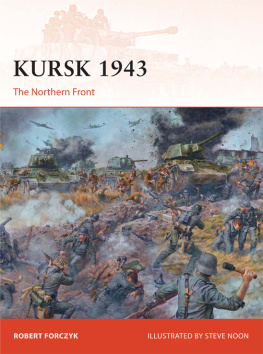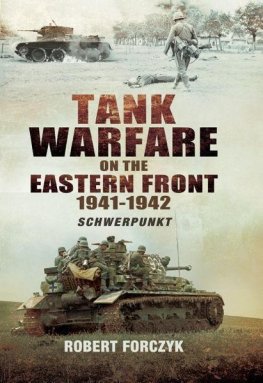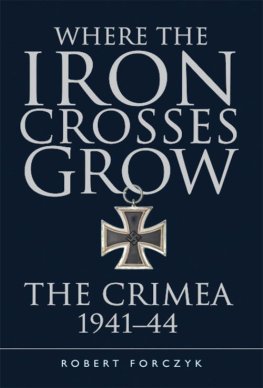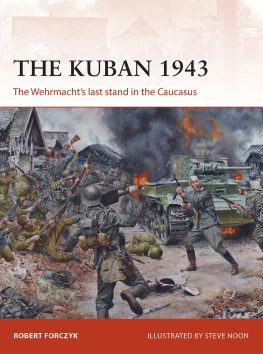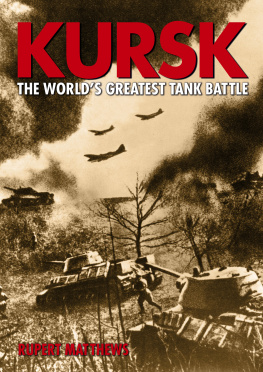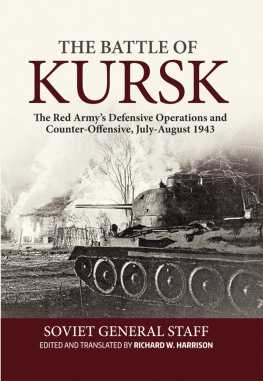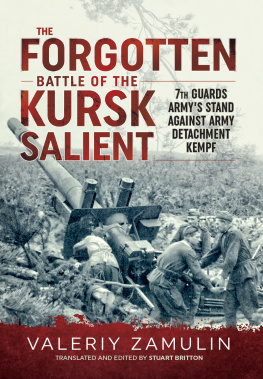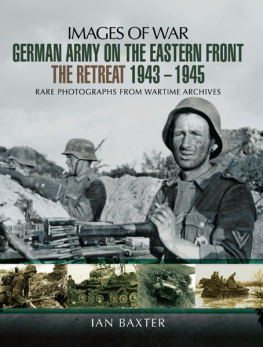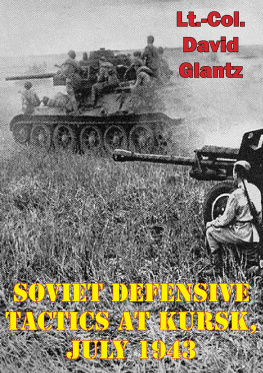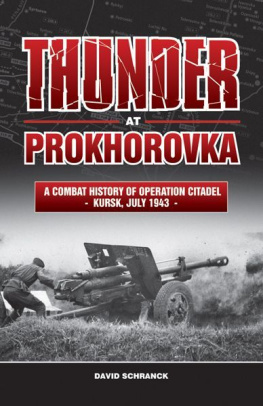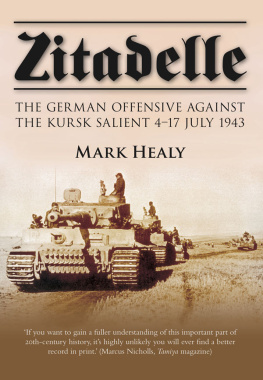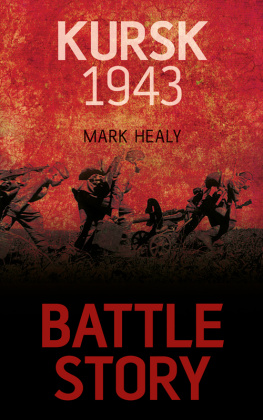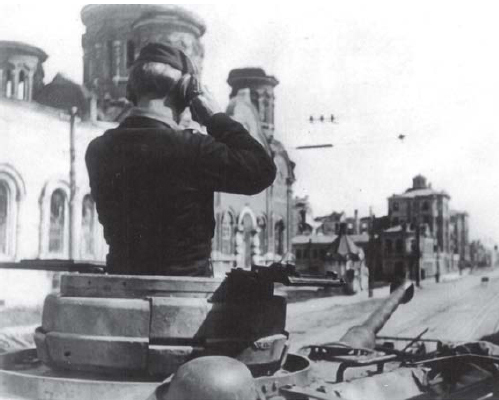CAMPAIGN 272
KURSK 1943
The Northern Front
| ROBERT FORCZYK | ILLUSTRATED BY STEVE NOON |
Series editor Marcus Cowper
CONTENTS
ORIGINS OF THE CAMPAIGN
After the crippling losses suffered during Operation Barbarossa and the subsequent Soviet winter counter-offensive, the German Army succeeded in rebuilding its shattered armoured forces by mid-1942, albeit at great cost. Hitler, always a gambler when it came to strategic decisions, decided to launch a new summer offensive in the southern Soviet Union to seize the oilfields of the Caucasus and to reach the river Volga. Yet in order to assemble the forces for this new offensive, designated Fall Blau (Case Blue), Hitler had to strip equipment and personnel from the two non-involved army groups, Heeresgruppe Nord and Heeresgruppe Mitte, to build up Heeresgruppe Sd. In particular, the panzer divisions in Heeresgruppe Mitte were reduced to only a single Panzer-Abteilung (battalion) each, equipped mostly with older models. All new tank production was diverted to re-equip the depleted panzer units in Heeresgruppe Sd. By the time Fall Blau began on 28 June 1942, Heeresgruppe Sd had been provided with 70 per-cent of Germanys armour on the Eastern Front, including 32 of Panzer-Abteilung 46 and 13 of Sturmgeschtz-Abteilung 21.
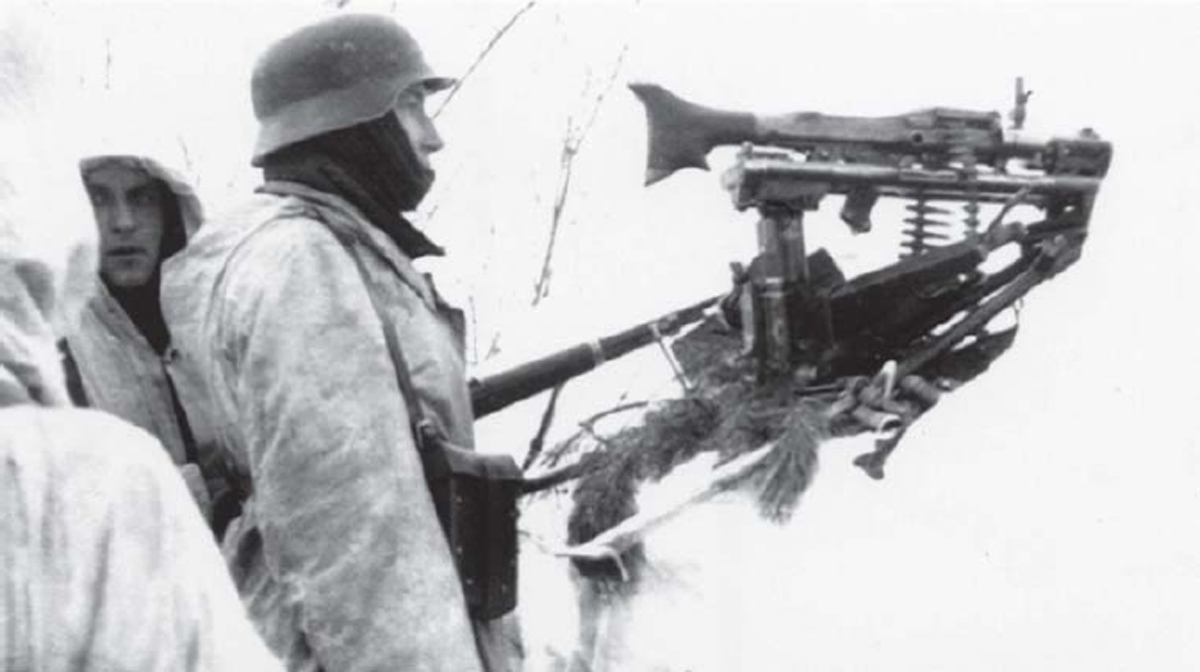
The German Army in Russia barely survived the Soviet winter counter-offensive of 1942/43. Even Heeresgruppe Mitte was hard pressed by Soviet offensives at Rzhev and near Orel. Hitler was concerned that the catastrophe at Stalingrad would cause German soldiers to doubt their leaders, and he was desperate to obtain an operational victory in the summer of 1943 to restore frontline morale. (Ian Barter)
Hitler weighted the forces deployed in the south to increase the likelihood of a successful offensive; however, this also increased the risk in the event of failure. Thus, when Armeeoberkommando (AOK) 6 and part of 4.Panzerarmee were encircled at Stalingrad by the Soviet counter-offensive in November 1942, the ensuing catastrophe affected all German forces on the Eastern Front. At Stalingrad, the Wehrmacht lost 6 of its 25 motorized divisions and 12 of its Panzer-Abteilungen.
After AOK 6 was encircled at Stalingrad, the Red Army launched a series of powerful counter-offensives that pushed Heeresgruppe Sd back all along the line and forced the Germans to abort their campaign in the Caucasus. By February 1943 Soviet armour had liberated Kharkov and was approaching Dnepropetrovsk. For a moment, the German position in southern Ukraine was on the verge of complete collapse. However, the Soviets narrowly failed to finish off Heeresgruppe Sd. Generalfeldmarschall Erich von Manstein was able to mount a desperate counterattack that recaptured Kharkov on 14 March 1943 and brought the Soviet advance to an ignominious halt. Nevertheless, the Soviets were left in possession of the Kursk salient, which protruded into the boundary between Heeresgruppe Mitte and Heeresgruppe Sd. By late March 1943 an unusual lull settled over the area around the Kursk salient.
While the Germans had committed the bulk of their armour in the south in 1942, the Red Army retained significant armoured units around Moscow. Georgy Zhukov, the deputy commander-in-chief of the Red Army, decided to use them against the weakened German Heeresgruppe Mitte. Zhukov believed that a powerful armoured drive towards Orel would divert German reserves from their operations in the south. On 5 July 1942 the Soviet Western Front attacked 2.Panzerarmees frontline north of Orel on two separate axes at Zhizdra and Bolkhov. Although the Soviet armour outnumbered the German armour 3:1, 2.Panzerarmee not only stopped the Soviet offensive, but also launched a counter-offensive named Wirbelwind that pushed the Soviets back. Zhukov made a second effort against 2.Panzerarmee in late August 1942 and even committed the newly formed 3rd Tank Army (3TA) to create a breakthrough. Nevertheless, the Germans succeeded in stopping the Western Front offensive and 3TA lost 500 of its 700 tanks. The tank battles north of Orel in July and August 1942 were some of the largest armoured engagements of the year, but they remain little known today.
Zhukov also made an effort to cut off Generaloberst Walter Models AOK 9 (9th Army) in the Rzhev salient, by massing over 2,300 tanks against the base of the salient. However, when Operation Mars was launched on 25 November 1942, it proved to be a fiasco that cost Zhukovs forces over 1,800 tanks. Model even succeeded in cutting off the Soviet armoured spearheads, thereby destroying two tank and two mechanized corps. Given these successes in 1942, the senior leadership in Heeresgruppe Mitte believed that Soviet numerical superiority could be blunted with superior defensive tactics.
Nevertheless, the long-term forecast for the Wehrmacht on the Eastern Front after Stalingrad looked increasingly bleak. In 1942 the Red Army lost about 20,000 tanks, while Soviet industry built 24,231 tanks and Anglo-American Lend-Lease provided another 10,500 tanks. This meant that the Red Army had experienced a net increase of more than 14,000 tanks by the beginning of 1943. At this point it was decided to phase out the KV-1 heavy tank in favour of producing larger numbers of the reliable T-34/76 medium tank. By July 1943 Soviet industry was manufacturing 1,393 T-34 tanks per month. In contrast, the Wehrmacht lost about 2,480 tanks on the Eastern Front in 1942, plus another 563 tanks in North Africa, while German industry built only 4,168 tanks in 1942. Even after the PzKpfw III had been phased out in early 1943, German tank production remained inadequate, with only 511 tanks being built in July 1943 (of which 244 were PzKpfw IV, 202 were Panthers and 65 were Tigers). Hitler hoped to counter the increasing Soviet numerical superiority in armour by introducing qualitatively superior tanks like the Tiger and Panther, but the diversion of industrial resources to construct these new models hindered increases in the production of the existing PzKpfw IV. By spring 1943 it was evident that the Red Army would enjoy a large numerical superiority in armour for the upcoming summer campaigns. It was questionable whether the Wehrmacht could regain the strategic initiative under these conditions.
Nevertheless, after partially rebuilding Heeresgruppe Sd, Hitler intended to conduct a limited objective offensive in the summer of 1943 to regain the initiative. He also wanted a tangible victory in order to bolster home-front morale and restore confidence within the Wehrmacht. Manstein, optimistic after his backhand blow victory at Kharkov, felt that the Soviet forces in the Kursk salient formed a tempting target. Although German offensive capabilities were much reduced from previous years, the elimination of the Soviet-held Kursk salient by means of a classic combined-arms pincer attack seemed feasible. In fair weather and with air support, this operational method had always worked for the Germans against the Red Army in the past. By encircling the bulk of the Soviet Central and Voronezh fronts in the Kursk salient, Hitler hoped that the resulting heavy losses of troops and materiel inflicted on the Red Army would grant the Wehrmacht sufficient time to recover its strength fully. He was looking for an easy victory, not a battle of attrition. However, Hitler had apparently overlooked the fact that similar efforts to encircle large Soviet formations during the opening stages of

